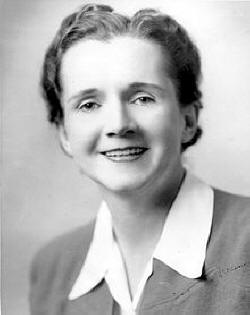

Queer Places:
Johns Hopkins University, Baltimore, MD 21218, Stati Uniti
Chatham University, 1 Woodland Rd, Pittsburgh, PA 15232, Stati Uniti
Silverledges, Southport, ME 04576, Stati Uniti
11701 Berwick Rd, Silver Spring, MD 20904, USA
Rachel Carson Homestead, 613 Marion Ave, Springdale, PA 15144, Stati Uniti
Parklawn Memorial Park, 12800 Veirs Mill Rd, Rockville, MD 20853, Stati Uniti
 Rachel Louise Carson (May 27, 1907 – April 14, 1964) was an American marine
biologist, author, and conservationist whose book Silent Spring and
other writings are credited with advancing the global environmental movement.
Rachel Louise Carson (May 27, 1907 – April 14, 1964) was an American marine
biologist, author, and conservationist whose book Silent Spring and
other writings are credited with advancing the global environmental movement.
Carson began her career as an aquatic biologist in the U.S. Bureau of Fisheries, and became a full-time nature writer in the 1950s. Her widely praised 1951 bestseller The Sea Around Us won her a U.S. National Book Award,[2] recognition as a gifted writer, and financial security. Her next book, The Edge of the Sea, and the reissued version of her first book, Under the Sea Wind, were also bestsellers. This sea trilogy explores the whole of ocean life from the shores to the depths.
Late in the 1950s, Carson turned her attention to conservation, especially some problems that she believed were caused by synthetic pesticides. The result was the book Silent Spring (1962), which brought environmental concerns to an unprecedented share of the American people. Although Silent Spring was met with fierce opposition by chemical companies, it spurred a reversal in national pesticide policy, which led to a nationwide ban on DDT and other pesticides. It also inspired a grassroots environmental movement that led to the creation of the U.S. Environmental Protection Agency.[3] Carson was posthumously awarded the Presidential Medal of Freedom by Jimmy Carter.
Carson first met Dorothy Freeman in the Summer of 1953 in Southport Island, Maine. Freeman had written to Carson welcoming her to the area when she had heard that the famous author was to become her neighbor. It was the beginning of an extremely close friendship that would last the rest of Carson's life. Their relationship was conducted mainly through letters, and during summers spent together in Maine. Over the course of 12 years, they would exchange somewhere in the region of 900 letters. Many of these were published in the book Always, Rachel, published in 1995 by Beacon Press.

Dorothy Murdoch (1898–1978) grew up in the coastal town of Marblehead, Massachusetts, and spent summers with her family in Southport, Maine. She worked in home economics until her marriage to Stanley Freeman in 1924. Their only child, Stanley Freeman, Jr., was born in 1926.[19]
Carson's biographer, Linda J. Lear, writes that "Carson sorely needed a devoted friend and kindred spirit who would listen to her without advising and accept her wholly, the writer as well as the woman."[20] She found this in Freeman. The two women had a number of common interests, nature chief among them, and began exchanging letters regularly while apart. They would share summers for the remainder of Carson's life, and meet whenever else their schedules permitted.[21]
In regard to the extent of their relationship, commentators have said that: "the expression of their love was limited almost wholly to letters and very occasional farewell kisses or holding of hands".[22] Freeman shared parts of Carson's letters with her husband to help him understand the relationship, but much of their correspondence was carefully guarded.[23]
Shortly before Carson's death, she and Freeman destroyed hundreds of letters. The surviving correspondence was published in 1995 as Always, Rachel: The Letters of Rachel Carson and Dorothy Freeman, 1952–1964: An Intimate Portrait of a Remarkable Friendship, edited by Freeman's granddaughter. According to one reviewer, the pair "fit Carolyn Heilbrun's characterization of a strong female friendship, where what matters is 'not whether friends are homosexual or heterosexual, lovers or not, but whether they share the wonderful energy of work in the public sphere'."[24]
Weakened from breast cancer and her treatment regimen, Carson became ill with a respiratory virus in January 1964. Her condition worsened, and in February, doctors found that she had severe anemia from her radiation treatments and in March they discovered that the cancer had reached her liver. She died of a heart attack on April 14, 1964, in her home in Silver Spring, Maryland.[1][73][74]
Her body was cremated and the ashes buried beside her mother at Parklawn Memorial Gardens, Rockville, Maryland.[75] Some of her ashes were later scattered along the coast of Southport Island, near Sheepscot Bay, Maine.
My published books: